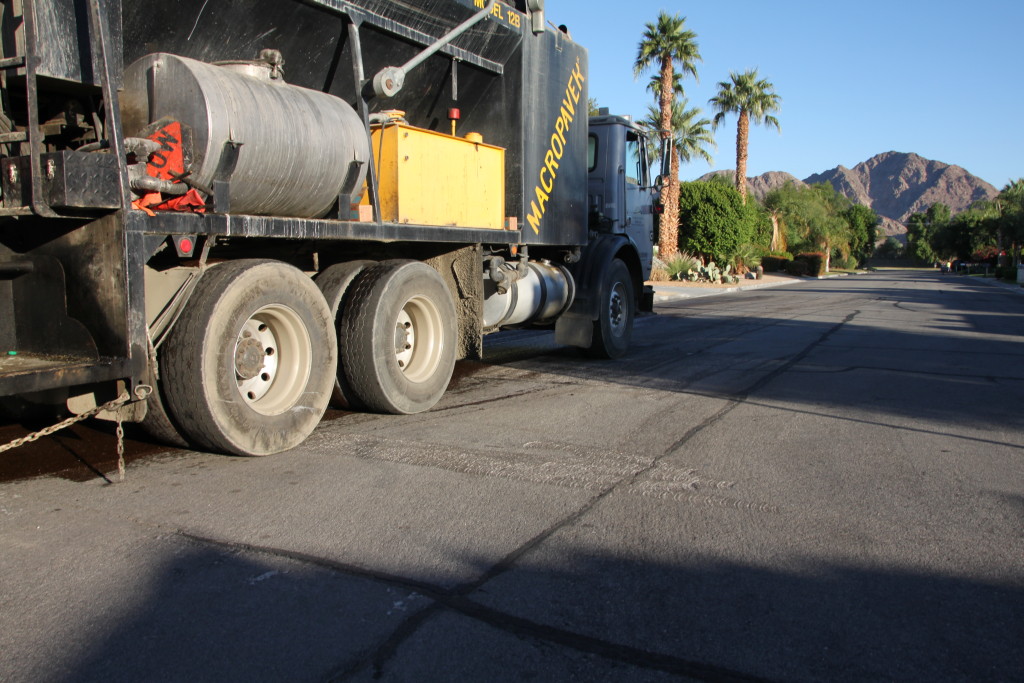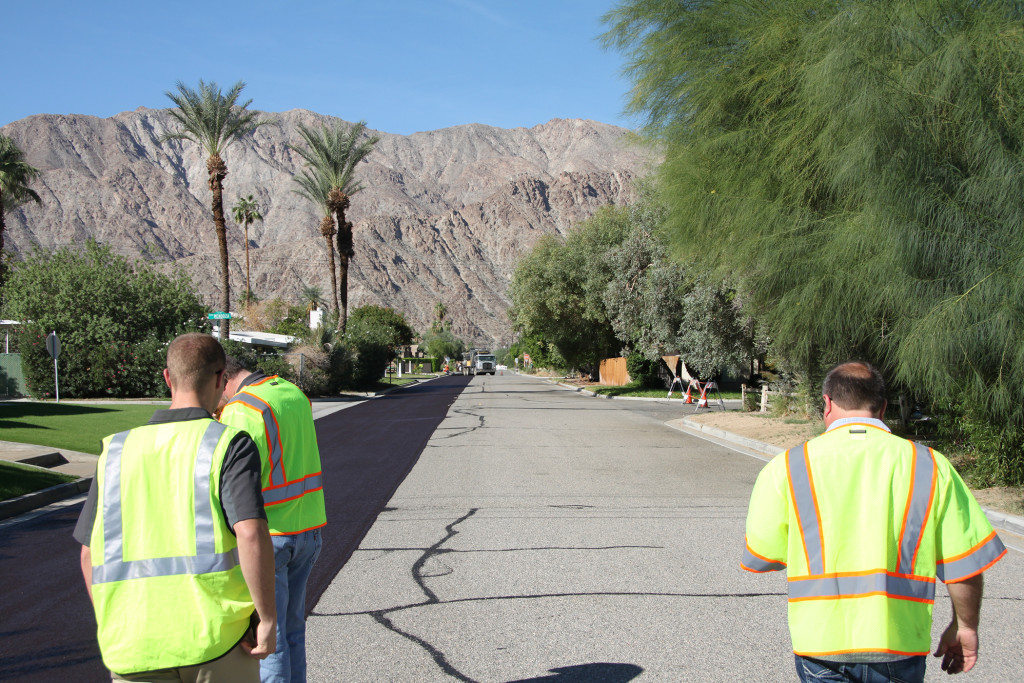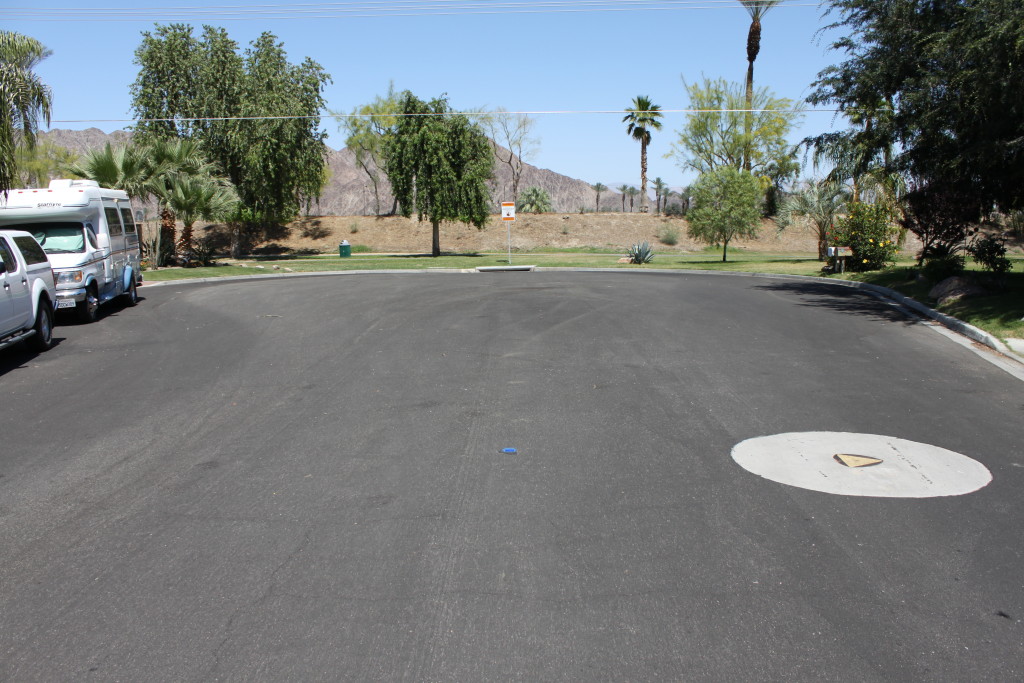
Background: Surface Damage Arises in Southern California
Some cities in California often experience road surface temperatures as high as 160°F, creating vulnerability in the roadways. For some residential streets in LaQuinta, California, just outside of Palm Springs, this vulnerability led to distresses such as hairline cracking, minor thermal cracking and aged, oxidized surface raveling. Crack sealer and traditional slurry seals had been applied to correct these issues in the past. It was discovered over time, however, during bouts of extremely high temperatures, traditional slurry seals are more susceptible to power steering burns and scuffing. This damage is often caused by local automobile traffic and utility traffic, such as garbage trucks.
American Asphalt South, Inc., (AAS) with Vice President Jeff Petty as Project Manager, was contracted to carry out a road maintenance plan using latex modified slurry seal. Latex modified slurry seals are more abrasion resistant than traditional slurry seals due to their polymer content. However, in extreme climate conditions, such as those in southern California, even modified slurry seals can often fall victim to extensive surface damage from the heat. American Asphalt South, Inc., (AAS) with Vice President Jeff Petty as Project Manager, was contracted to carry out a road maintenance plan using latex modified slurry seal. Latex modified slurry seals are more abrasion resistant than traditional slurry seals due to their polymer content. However, in extreme climate conditions, such as those in southern California, even modified slurry seals can often fall victim to extensive surface damage from the heat. Ergon Asphalt & Emulsions, Inc.’s Area Sales Managers Todd Vargason and Tom Hicks, both well-respected experts on pavement preservation in the region, became aware of the project and saw this as an opportunity to showcase Ergon A&E’s new eFlex premium micro surfacing solution as a more durable and effective treatment.Ergon Asphalt & Emulsions, Inc.’s Area Sales Managers Todd Vargason and Tom Hicks, both well-respected experts on pavement preservation in the region, became aware of the project and saw this as an opportunity to showcase Ergon A&E’s new eFlex premium micro surfacing solution as a more durable and effective treatment.
eFlex, part of the e-Series family of pavement preservation and maintenance products, is an innovative new emulsion product ideal for residential applications due to its durability under stop-and-go traffic conditions. It is significantly tougher than its traditional and modified counterparts. Its increased level of polymer modification in the base asphalt gives roads greater ability to withstand extremely high temperatures. This promotes flexibility in the pavement surface allowing it to rebound from traffic friction, minimizing the negative effects of scuffing and power steering burns.
eFlex Takes on Latex Modified Slurry Seal
Meeting city specifications, AAS decided to test eFlex against the latex modified slurry seal and evaluate their overall respective performances. While a significant improvement in performance was expected with both competitively priced solutions over the traditional slurry seal, AAS was interested in noting whether eFlex would live up to its promises.
Application Highlights
The date for application was set for October 22, 2014. AAS primed the eFlex micro surfacing emulsion, combining it with crushed aggregate supplied by Coachella Valley Aggregates, Inc. Preparing for a smooth application, Ergon A&E Technical Operations team members Bill Grubba, Vice President of Technical Operations & Plant Technology, and Joel Shealey, Technical Operations Manager, were on site for the duration of the project to address technical questions. Todd was also on site overseeing that proper proportion adjustments were made throughout the process. He also coordinated with Ergon A&E’s Las Vegas emulsion plant to ensure a consistent supply of eFlex emulsion was on-hand for the project.
The treatment was applied at a rate of 15 pounds per square yard to a combined total of 23 blocks, along the 8 designated roadways. The eFlex cure time was less than two hours on each of the treated roads, allowing traffic to be returned to the surface with minimal inconvenience to local residents.
Results
The contractor was impressed with the overall performance of eFlex, and within the first week observed significantly improved resistance to tire damage. While a better alternative than traditional applications, latex modified slurry seals still showed considerable damage in extreme heat conditions. The contractor estimated an 80% decrease in power steering burns and scuffing on eFlex roads, as compared to the streets treated with latex modified slurry. There were no repairs necessary to the streets receiving the eFlex application. This is significant in that contractors acquire mounting repair costs addressing surface damage following the residential application of slurry seals. As an added benefit, there was no raveling present on the eFlex-treated streets and cul-de-sacs.
Project Update: Six Months Later
Six months following the application, temperatures began to rise above 100°F. Todd revisited the site observing sustained durability and protection from raveling in the eFlex treated cul-de-sacs. Scuffing also remained low, with approximately 80% less damage observed, as compared to the latex modified slurry seal surfaces. There have been no damage complaints from residents living on the eFlex streets.
Long-Term Strategy
Todd and Tom were major driving forces behind integrating eFlex into this project; its success further elevates their status as industry resources in the southern California region. Ergon A&E expects the outcome of this project will lead to a partnership with American Asphalt South to promote eFlex in 21 other desert cities in the Palm Springs area.










